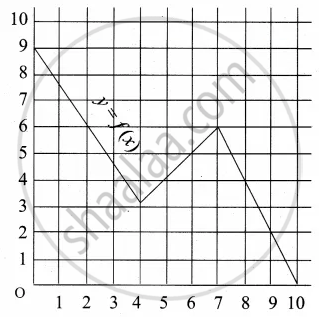Advertisements
Advertisements
प्रश्न
Check the injectivity and surjectivity of the following function.
f : N → N given by f(x) = x3
उत्तर
f : N → N given by f(x) = x3
Let f(x1) = f(x2)
∴ x13 = x23
∴ x13 – x23 = 0
∴ `(x_1 - x_2) underbrace((x_1^2 + x_1 x_2 + x_2^2))_(> 0 "for all" "x"_1, "x"_2 "as it's discriminant" < 0)` = 0
∴ x1 = x2
∴ f is injective.
Numbers from codomain which are not cubes of natural numbers are not images under f.
∴ f is not surjective.
APPEARS IN
संबंधित प्रश्न
Define a function as a correspondence between two sets.
What is the fundamental difference between a relation and a function? Is every relation a function?
The function f is defined by \[f\left( x \right) = \begin{cases}x^2 , & 0 \leq x \leq 3 \\ 3x, & 3 \leq x \leq 10\end{cases}\]
The relation g is defined by \[g\left( x \right) = \begin{cases}x^2 , & 0 \leq x \leq 2 \\ 3x, & 2 \leq x \leq 10\end{cases}\]
Show that f is a function and g is not a function.
If \[f\left( x \right) = \frac{2x}{1 + x^2}\] , show that f(tan θ) = sin 2θ.
If f, g, h are real functions given by f(x) = x2, g(x) = tan x and h(x) = loge x, then write the value of (hogof)\[\left( \sqrt{\frac{\pi}{4}} \right)\] .
Let f and g be two functions given by
f = {(2, 4), (5, 6), (8, −1), (10, −3)} and g = {(2, 5), (7, 1), (8, 4), (10, 13), (11, −5)}.
Find the domain of f + g
Let f and g be two real functions given by
f = {(0, 1), (2, 0), (3, −4), (4, 2), (5, 1)} and g = {(1, 0), (2, 2), (3, −1), (4, 4), (5, 3)}
Find the domain of fg.
If f(x) = cos (log x), then the value of f(x2) f(y2) −
If \[f\left( x \right) = \log \left( \frac{1 + x}{1 - x} \right) \text{ and} g\left( x \right) = \frac{3x + x^3}{1 + 3 x^2}\] , then f(g(x)) is equal to
The domain of the function
The range of the function f(x) = |x − 1| is
The range of \[f\left( x \right) = \frac{1}{1 - 2\cos x}\] is
If f(x) = ax2 + bx + 2 and f(1) = 3, f(4) = 42, find a and b.
Which sets of ordered pairs represent functions from A = {1, 2, 3, 4} to B = {−1, 0, 1, 2, 3}? Justify.
{(1, 0), (3, 3), (2, −1), (4, 1), (2, 2)}
Check if the relation given by the equation represents y as function of x:
3x − 6 = 21
Find x, if g(x) = 0 where g(x) = x3 − 2x2 − 5x + 6
Find the domain and range of the following function.
g(x) = `(x + 4)/(x - 2)`
Find the domain and range of the following function.
f(x) = `sqrt((x - 3)/(7 - x))`
Express the area A of a square as a function of its perimeter P
Express the following exponential equation in logarithmic form
3–4 = `1/81`
Write the following expression as sum or difference of logarithm
In `(("a"^3 ("a" - 2)^2)/sqrt("b"^2 + 5))`
The equation logx2 16 + log2x 64 = 3 has,
Select the correct answer from given alternatives.
If f(x) =`1/(1 - x)`, then f{f[f(x)]} is
Answer the following:
If `log (("a" + "b")/2) = 1/2(log"a" + log"b")`, then show that a = b
Answer the following:
Solve : `sqrt(log_2 x^4) + 4log_4 sqrt(2/x)` = 2
Answer the following:
Find the range of the following function.
f(x) = [x] – x
A graph representing the function f(x) is given in it is clear that f(9) = 2

Describe the following Domain
If f(x) = `{{:(x^2",", x ≥ 0),(x^3",", x < 0):}`, then f(x) is ______.
Find the domain for which the functions f(x) = 2x2 – 1 and g(x) = 1 – 3x are equal.
Redefine the function f(x) = x − 2 + 2 + x , – 3 ≤ x ≤ 3
If f(x) = `(x - 1)/(x + 1)`, then show that `f(1/x)` = – f(x)
If f(x) = x3 – 1 and domain of f = {0, 1, 2, 3}, then domain of f–1 is ______.
If f: R `rightarrow` R be a function defined by f(x) = 4x3 – 7. Then ______.
lf f : [0, ∞) `rightarrow` [0, ∞) and f(x) = `x/(1 + x)`, then f is ______.
Range of the function f(x) = `x/(1 + x^2)` is ______.
